 W
WThe artery of bulb of penis is a short artery of large caliber which arises from the internal pudendal artery between the two layers of fascia of the urogenital diaphragm. It passes medialward, pierces the inferior fascia of the urogenital diaphragm and gives off branches which ramify in the bulb of the urethra and in the posterior part of the corpus spongiosum.
 W
WThe body of the penis extends from the root to the ends of the corpora cavernosa penis, and in it these corpora cavernosa are intimately bound to one another with a dorsally fenestrated septum which becomes a complete one before penile crura.
 W
WBuck's fascia is a layer of deep fascia covering the three erectile bodies of the penis.
 W
WJust before each crus of the penis meets its fellow, it presents a slight enlargement, which Georg Ludwig Kobelt named the bulb of the corpus cavernosum penis. The bulb of penis is also known as the urethral bulb.
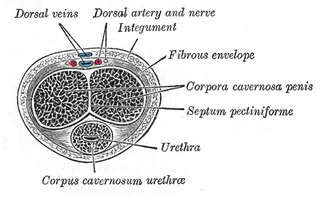 W
WA corpus cavernosum penis (singular) is one of a pair of sponge-like regions of erectile tissue, which contain most of the blood in the penis during an erection.
 W
WThe corpus spongiosum is the mass of spongy tissue surrounding the male urethra within the penis. It is also called the corpus cavernosum urethrae in older texts.
 W
WFor their anterior three-fourths the corpora cavernosa penis lie in intimate apposition with one another, but behind they diverge in the form of two tapering processes, known as the crura, which are firmly connected to the ischial rami.
 W
WThe deep artery of the penis, one of the terminal branches of the internal pudendal, arises from that vessel while it is situated between the two fasciæ of the urogenital diaphragm.
 W
WThe Dorsal Artery of the Penis is a branch of the internal pudendal artery which ascends between the crus penis and the pubic symphysis, and, piercing the inferior fascia of the urogenital diaphragm, passes between the two layers of the suspensory ligament of the penis, and runs forward on the dorsum of the penis to the glans, where it divides into two branches, which supply the glans and prepuce. The dorsal arteries do give perforators to the corpora cavernosa, however their contribution to erectile function is inconsistent. Through retrograde flow they help supply the distal shaft skin. Additionally, they give branches to the circumflex arteries which supply the corpus spongiosum. The major clinical relevance is in the case of traumatic amputation of the penis, failure to perform re-anastomosis of the dorsal arteries leads to skin loss.
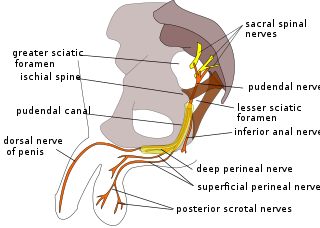 W
WThe dorsal nerve of the penis is the deepest division of the pudendal nerve; it accompanies the internal pudendal artery along the ramus of the ischium; it then runs forward along the margin of the inferior ramus of the pubis, between the superior and inferior layers of the fascia of the urogenital diaphragm.
 W
WIn human anatomy, the dorsal veins of the penis comprise the superficial dorsal vein of the penis and the deep dorsal vein of the penis.
 W
WThe ejaculatory ducts are paired structures in male anatomy. Each ejaculatory duct is formed by the union of the vas deferens with the duct of the seminal vesicle. They pass through the prostate, and open into the urethra at the seminal colliculus. During ejaculation, semen passes through the prostate gland, enters the urethra and exits the body via the urinary meatus.
 W
WThe foreskin is the double-layered fold of smooth muscle tissue, blood vessels, neurons, skin, and mucous membrane part of the penis that covers and protects the glans penis and the urinary meatus. The foreskin is mobile, fairly stretchable, and acts as a natural lubricant. It is also described as the prepuce, a technically broader term that also includes the clitoral hood in women, to which the foreskin is embryonically homologous.
 W
WThe frenular delta in human anatomy is located below the penile glans along the penile ventral body. It is composed of the preputial mucosa, and is triangular in shape. The frenulum is located at the tip of the triangle, the ridged bands form the sides of the triangle, and the junctional rim forms the triangle's base. This area, especially the frenulum itself, is reported to be the most sensitive area of the penis. The delta is highly innervated, and is considered to be a specific erogenous zone.
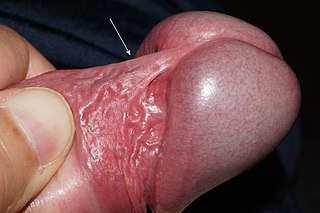 W
WThe frenulum of prepuce of penis, often known simply as the frenulum, is a highly erogenous elastic band of tissue under the glans penis that connects the foreskin to the vernal mucosa, and helps contract the foreskin over the glans. Along with the ridged bands at the tip of the foreskin, it is considered to be the most sensitive part of the penis to fine-touch.
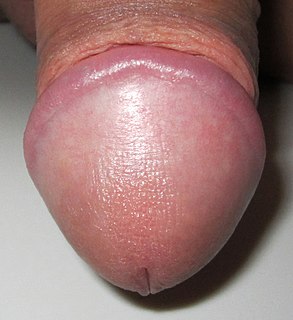 W
WThe glans penis, more commonly referred to as the glans, is a structure at the distal end of the penis in male mammals. It is the sensitive bulbous structure at the end of the human penis, and is anatomically homologous to the clitoral glans of the human female. The glans penis may be smooth, spiny, elongated, or divided in other mammals.
 W
WThe helicine arteries of penis are arteries in the penis. They are found in the corpora cavernosa penis.
 W
WHirsuties coronae glandis are small protuberances that may form on the ridge of the glans of the human penis. They are a form of acral angiofibromas. They are a normal anatomical variation in humans and are sometimes described as vestigial remnants of penile spines, sensitive features found in the same location in other primates. In species in which penile spines are expressed, as well as in humans who have them, the spines are thought to contribute to sexual pleasure and quicker orgasms. It has been theorized that pearly penile papules stimulate the female vagina during sexual intercourse. In addition, pearly penile papules secrete oil that moistens the glans of the penis.
 W
WIn male anatomy, the lacuna magna is the largest of several recesses in the roof of the navicular fossa of the urethra. Its embryologic origin is contested, but recent evidence suggests it and the navicular fossa derive from infiltrating endodermal cells of the urethral plate. In young males, the presence of the lacuna magna is associated with painful urination (dysuria), bloody urine (hematuria), and bloody spotting of underwear.
 W
WThe penile artery is the artery that serves blood to the penis.
 W
WThe ridged band is a band of highly erogenous mobile skin toward the end of the foreskin. Along with the frenulum of the penis, it is considered to be the most sensitive part of the penis to fine-touch.
 W
WThe root of the penis is triradiate in form, consisting of the diverging crura, one on either side, and the median urethral bulb.
 W
WThe corpora cavernosa penis are surrounded by a strong fibrous envelope consisting of superficial and deep fibers. The superficial fibers are longitudinal in direction, and form a single tube which encloses both corpora; the deep fibers are arranged circularly around each corpus, and form by their junction in the median plane the septum of the penis.
 W
WThe subcutaneous tissue of penis is continuous above with the fascia of Scarpa, and below with the dartos tunic of the scrotum and the fascia of Colles.
 W
WIn males, the suspensory ligament of the penis is attached to the pubic symphysis, which holds the penis close to the pubic bone and supports it when erect.
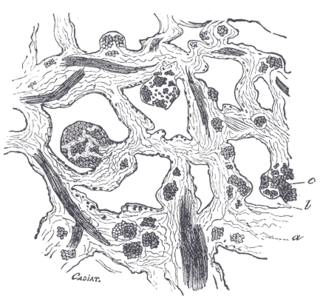 W
WFrom the internal surface of the fibrous envelope of the corpora cavernosa penis, as well as from the sides of the septum, numerous bands or cords are given off, which cross the interior of these corpora cavernosa in all directions, subdividing them into a number of separate compartments, and giving the entire structure a spongy appearance.
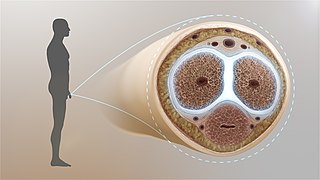 W
WThe tunica albuginea is the fibrous envelope that extends the length of the corpora cavernosa penis and corpus spongiosum penis. It is a bi-layered structure that includes an outer longitudinal layer and an inner circular layer. It consists of approximately 5% elastin, with the remainder mostly consisting of collagen.